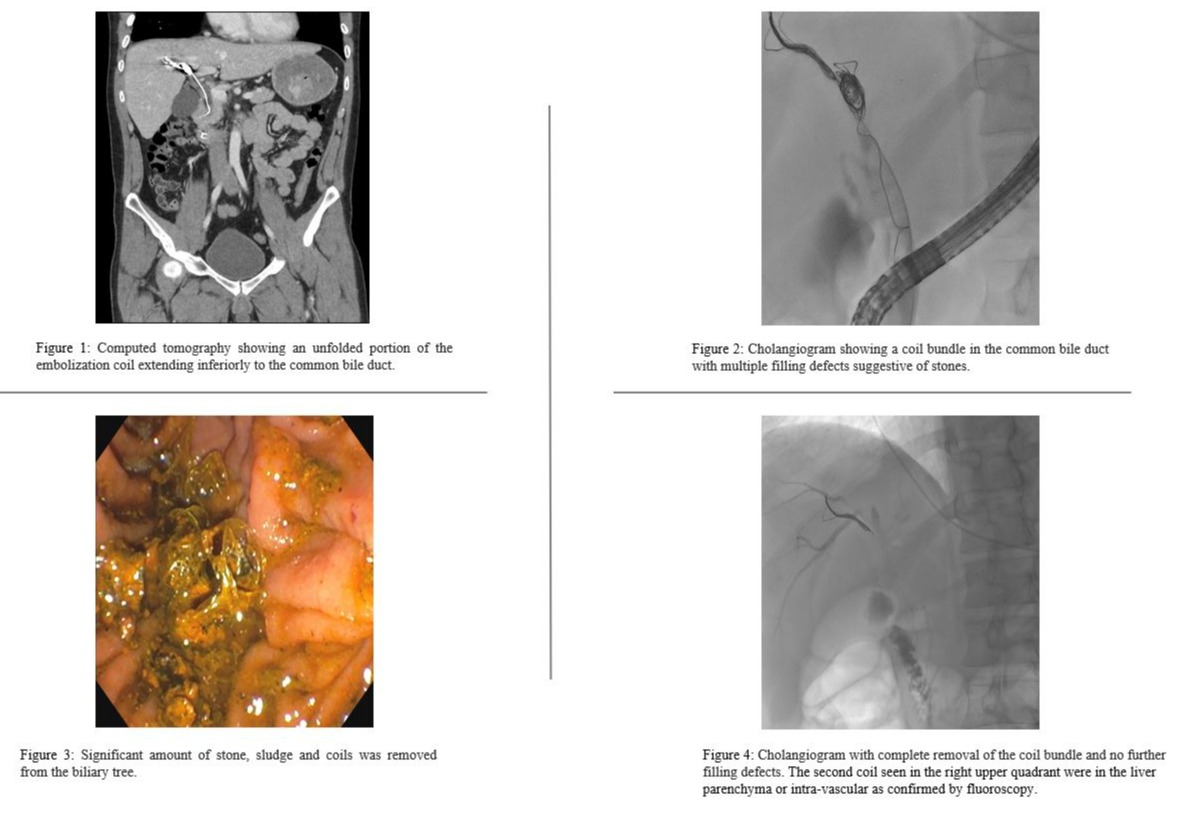Back
Poster Session D - Tuesday Morning
Category: Biliary/Pancreas
D0056 - Coil-Angitis: A Rare Case of Coil Migration into the Biliary Tree
Tuesday, October 25, 2022
10:00 AM – 12:00 PM ET
Location: Crown Ballroom
- AB
Aliana M. Bofill-Garcia, MD
Mayo Clinic
Rochester, MN
Presenting Author(s)
Aliana M. Bofill-Garcia, MD, Ryan Law, DO
Mayo Clinic, Rochester, MN
Introduction: Embolization coils are commonly used to manage hemorrhage after liver injury; however, migration into the biliary tree is uncommon. When this occurs, symptoms of biliary obstruction might develop such as jaundice, cholangitis, stone formation and pancreatitis. Physicians may not be aware of this potential risk, resulting in a delay in diagnosis and an increased morbidity and mortality risk. Herein, we present the case of a patient with history of liver laceration requiring bile duct embolization, and concurrent bile leak, presenting >3 years later with ascending cholangitis.
Case Description/Methods: A 27-year-old male with remote history of motor vehicle accident complicated by a liver laceration presented to the ED with one-week onset of right upper quadrant (RUQ) pain, vomiting, and fever. Evaluation at admission was notable for fever of 100.3F, RUQ tenderness, white blood cell count of 13.000/mL. Liver chemistries with bilirubin of 5.0mg/dL, ALT 405U/L, AST 217U/L, ALP 200U/L, consistent with obstructive pattern. Computed tomography showed sequela of liver laceration and bile duct embolization in segment 8, with an unfolded portion of the embolization coil extending inferiorly to the common bile duct, and a dilated bile duct to 15mm (Figure 1). The patient was started on antibiotics and underwent urgent ERCP with findings of a coil bundle in the common bile duct with adherent stone and cast material surrounding the coil cast (Figure 2). The wire bundle was successfully removed using the extraction balloon and an endoscopic forceps. A significant amount of stone, sludge and pus was also removed from the duct (Figure 3). The final cholangiogram demonstrated no further evidence of intraductal embolization coils or other filling defects (Figure 4). His pain was relieved, and he was discharged with a common bile duct stent and outpatient follow-up.
Discussion: Cholangitis due to biliary coil migration represents an unusual, delayed complication from endovascular embolization. The migrated coil serves as a nidus for stone formation, leading to choledocholithiasis and cholangitis. Our patient was managed successfully with ERCP allowing coil extraction with a favorable outcome. Similar cases of this possible complication have been rarely described in the literature. Our case highlights an uncommon cause of life-threatening cholangitis, warranting a high degree of suspicion and need for detailed documentation of prior interventions.

Disclosures:
Aliana M. Bofill-Garcia, MD, Ryan Law, DO. D0056 - Coil-Angitis: A Rare Case of Coil Migration into the Biliary Tree, ACG 2022 Annual Scientific Meeting Abstracts. Charlotte, NC: American College of Gastroenterology.
Mayo Clinic, Rochester, MN
Introduction: Embolization coils are commonly used to manage hemorrhage after liver injury; however, migration into the biliary tree is uncommon. When this occurs, symptoms of biliary obstruction might develop such as jaundice, cholangitis, stone formation and pancreatitis. Physicians may not be aware of this potential risk, resulting in a delay in diagnosis and an increased morbidity and mortality risk. Herein, we present the case of a patient with history of liver laceration requiring bile duct embolization, and concurrent bile leak, presenting >3 years later with ascending cholangitis.
Case Description/Methods: A 27-year-old male with remote history of motor vehicle accident complicated by a liver laceration presented to the ED with one-week onset of right upper quadrant (RUQ) pain, vomiting, and fever. Evaluation at admission was notable for fever of 100.3F, RUQ tenderness, white blood cell count of 13.000/mL. Liver chemistries with bilirubin of 5.0mg/dL, ALT 405U/L, AST 217U/L, ALP 200U/L, consistent with obstructive pattern. Computed tomography showed sequela of liver laceration and bile duct embolization in segment 8, with an unfolded portion of the embolization coil extending inferiorly to the common bile duct, and a dilated bile duct to 15mm (Figure 1). The patient was started on antibiotics and underwent urgent ERCP with findings of a coil bundle in the common bile duct with adherent stone and cast material surrounding the coil cast (Figure 2). The wire bundle was successfully removed using the extraction balloon and an endoscopic forceps. A significant amount of stone, sludge and pus was also removed from the duct (Figure 3). The final cholangiogram demonstrated no further evidence of intraductal embolization coils or other filling defects (Figure 4). His pain was relieved, and he was discharged with a common bile duct stent and outpatient follow-up.
Discussion: Cholangitis due to biliary coil migration represents an unusual, delayed complication from endovascular embolization. The migrated coil serves as a nidus for stone formation, leading to choledocholithiasis and cholangitis. Our patient was managed successfully with ERCP allowing coil extraction with a favorable outcome. Similar cases of this possible complication have been rarely described in the literature. Our case highlights an uncommon cause of life-threatening cholangitis, warranting a high degree of suspicion and need for detailed documentation of prior interventions.

Figure: Figures 1,2,3,4
Disclosures:
Aliana Bofill-Garcia indicated no relevant financial relationships.
Ryan Law: Boston Scientific – Consultant. ConMed – Consultant. Medtronic – Consultant. Olympus – Consultant. UpToDate – Royalties.
Aliana M. Bofill-Garcia, MD, Ryan Law, DO. D0056 - Coil-Angitis: A Rare Case of Coil Migration into the Biliary Tree, ACG 2022 Annual Scientific Meeting Abstracts. Charlotte, NC: American College of Gastroenterology.
